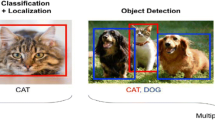Abstract
An efficient feature detection algorithm and image classification is a very crucial task in computer vision system. There are various state-of-the-art feature detectors and descriptors available for an object recognition task. In this paper, the authors have compared the performance of Shi-Tomasi corner detector with SIFT and SURF feature descriptors and evaluate the performance of Shi-Tomasi in combination with SIFT and SURF feature descriptors. To make the computations faster, authors have reduced the size of features computed in all cases by applying locality preserving projection methodology. Features extracted using these algorithms are further classified with various classifiers like K-NN, decision tree and random forest. For experimental work, a public dataset, namely Caltech-101 image dataset, is considered in this paper. This dataset comprises of 101 object classes. These classes have further contained many images. Using a combination of Shi-Tomasi, SIFT and SURF features, the authors have achieved a recognition accuracy of 85.9%, 80.8% and 74.8% with random forest, decision tree and K-NN classifier, respectively. In this paper, the authors have also computed true positive rate, false positive rate and area under curve in all cases. Finally, the authors have applied the adaptive boosting methodology to improve the recognition accuracy. Authors have reported improved recognition accuracy of 86.4% using adaptive boosting with random forest classifier and a combination of Shi-Tomasi, SIFT and SURF features.





Similar content being viewed by others
References
Anupama HS, Cauvery NK, Lingaraju GM (2015) k-NN based object recognition system using brain computer interface. Int J Comp Appl 120(2):35–38
Azad P, Asfour T and Dillmann R (2009). Combining Harris interest points and the sift descriptor for fast scale-invariant object recognition. In: Proceedings of the International Conference on Intelligent Robots and Systems, pp 4275–4280.
Bansal M, Kumar M, Kumar M (2020) 2D Object recognition techniques: state-of-the-art work. Arch Comput Methods Eng. https://doi.org/10.1007/s11831-020-09409-1
Bansal M, Kumar M and Kumar M (2020b). XGBoost: Object Recognition Using Shape Descriptors and Extreme Gradient Boosting Classifier. https://doi.org/10.1007/978-981-15-6876-3_16.
Bay H, Tuytelaars T and Gool LV (2006). Surf: Speeded up robust features. In: Proceedings of the European Conference on Computer Vision, pp 404–417.
Bosch A, Zisserman A and Munoz X (2007). Image classification using random forests and ferns. In: Proceedings of the IEEE 11th International Conference on Computer Vision, 1–8.
Du W and Zhan Z (2002). Building decision tree classifier on private data. In: Proceedings of the IEEE International Conference on Privacy, Security and Data Mining, 14:1–8
Fularz M, Kraft M (2015) Hardware implementation of a decision tree classifier for object recognition applications. Measure Autom Monitor 61(7):379–381
Gall J, Razavi N and Gool LV (2012) An introduction to random forests for multi-class object detection. In: Proceedings of the Outdoor and Large-Scale Real-World Scene Analysis, pp 243–263.
Galleguillos C, Rabinovich A and Belongie S (2008). Object categorization using co-occurrence, location and appearance. In: Proceedings of the IEEE Conference on Computer Vision and Pattern Recognition, pp 1–8
Guo GD and Zhang HJ (2001). Boosting for fast face recognition. In: Proceedings IEEE ICCV Workshop on Recognition, Analysis, and Tracking of Faces and Gestures in Real-Time Systems, p p96–100.
Gupta S, Kumar M, Garg A (2019) Improved object recognition results using SIFT and ORB feature detector. Multimed Tools Appl 78(34157–34171):2019
Harris CG and Stephens M (1988). A combined corner and edge detector. In: Proceedings of the Alvey Vision Conference, 15(50):10–52
Hauska H and Swain PH (1975). The decision tree classifier: design and potential. In: Proceedings of the Symposium on Machine Processing of Remotely Sensed Data, pp 38–48.
Kang M and Kim J (2007). Real time object recognition using K-nearest neighbor in parametric Eigen space. In: Proceedings of International Conference on Life System Modeling and Simulation, pp 403–411.
CS Kenney, M Zuliani, BS Manjunath 2005 An axiomatic approach to corner detection. In: Proceedings of the IEEE Computer Society Conference on Computer Vision and Pattern Recognition 1: 191-197
Kim J, Kim BS and Savarese S (2012). Comparing image classification methods: K-nearest-neighbor and support-vector-machines. In: Proceedings of the Applied Mathematics in Electrical and Computer Engineering, pp 133–138.
Li W, Dong P, Xiao B, Zhou L (2016) Object recognition based on the region of interest and optimal bag of words model. Neurocomputing 172:271–280
DG Lowe 1999 Object recognition from local scale-invariant features In: Proceedings of the International Conference on Computer Vision 99(2): 1150-1157
McFee B, Galleguillos C, Lanckriet G (2011) Contextual object localization with multiple kernel nearest neighbor. IEEE Trans Image Process 20(2):570–585
Muralidharan R (2014) Object recognition using k-nearest neighbor supported by Eigen value generated from the features of an image. Int J Innov Res Comp Commun Eng 2(8):5521–5528
Murphy-Chutorian E and Triesch J (2005). January. Shared features for scalable appearance-based object recognition. In: Proceedings of the 7th IEEE Workshops on Applications of Computer Vision, 1(1):16–21.
Schmidt A, Kraft M and Kasiński A (2010). An evaluation of image feature detectors and descriptors for robot navigation. In: Proceedings of the International Conference on Computer Vision and Graphics, pp 251–259.
Shi J and Tomasi C (1994). Good Features to Track. In: Proceedings of the IEEE Computer Society Conference on Computer Vision and Pattern Recognition (CVPR), pp 593–600.
Welke K, Azad P and Dillmann R (2006). Fast and robust feature-based recognition of multiple objects. In: Proceedings of the 6th IEEE-RAS International Conference on Humanoid Robots, pp 264–269.
Wu M, Ramakrishnan N, Lam SK and Srikanthan T (2012) Low-complexity pruning for accelerating corner detection. In: Proceedings of the 2012 IEEE International Symposium on Circuits and Systems, pp 1684–1687.
Author information
Authors and Affiliations
Corresponding author
Ethics declarations
Conflict of interest
The authors declare that they have no conflict of interest. For experimental work, authors have considered Caltech-101 image dataset in this paper. This dataset comprises of 101 object classes.
Additional information
Communicated by V. Loia.
Rights and permissions
About this article
Cite this article
Bansal, M., Kumar, M., Kumar, M. et al. An efficient technique for object recognition using Shi-Tomasi corner detection algorithm. Soft Comput 25, 4423–4432 (2021). https://doi.org/10.1007/s00500-020-05453-y
Published:
Issue Date:
DOI: https://doi.org/10.1007/s00500-020-05453-y




